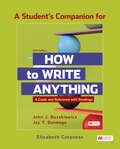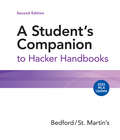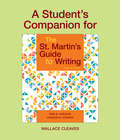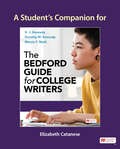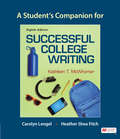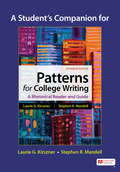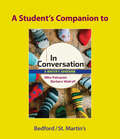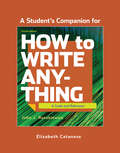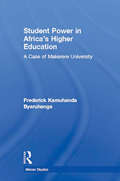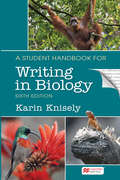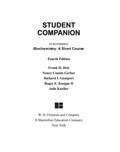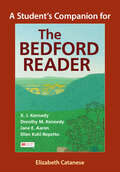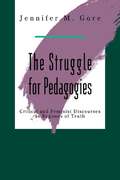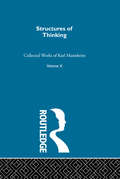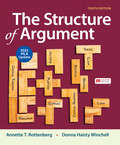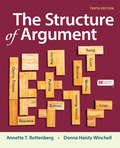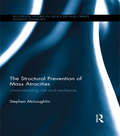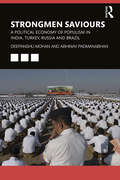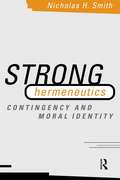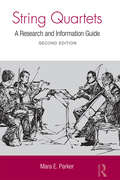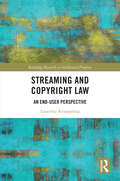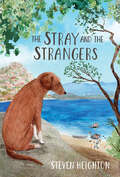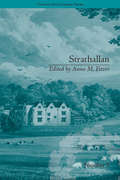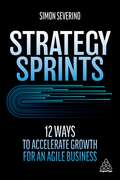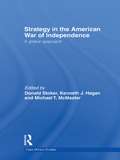Special Collections
Benetech’s Global Certified Accessible Titles
Description: Benetech’s GCA program is the first independent third-party EPUB certification to verify ebook accessibility. By creating content that is born accessible, publishers can meet the needs of all readers. Learn more: https://bornaccessible.benetech.org/
- Table View
- List View
A Student's Companion to How to Write Anything with Readings
by John Ruszkiewicz and Elizabeth Catanese and Jay DolmageOffering practical support for students in corequisite composition courses (including ALP, support, labs, workshops, etc.), the Student’s Companion provides tips for student success, including advice about time management, academic planning, and test anxiety, as well as sentence strategies for academic writing. Available at no additional cost to students when packaged with How to Write Anything. Also available in Achieve.
A Student's Companion to Hacker Handbooks with 2021 MLA Update
by Bedford/St.Martin'sThis ebook has been updated to provide you with the latest guidance on documenting sources in MLA style and follows the guidelines set forth in the MLA Handbook, 9th edition (April 2021). Writers develop over time. And the fact is, some writers need more time and more practice to develop the skills and habits that help them meet the challenges of the first-year writing course. For those students enrolled in paired, co-requisite, or ALP sections, A Student’s Companion to Hacker Handbooks offers practical support that will help them get up to speed and perform on-level.
A Student’s Companion for The St. Martin’s Guide to Writing
by Wallace CleavesThis new supplement is designed for anyone who needs a little extra help to write successfully on the college level. The text includes • material for student success, including support for building confidence, managing time effectively, and writing ethically • sentence guides, rubrics, and activities to help students develop, draft, and revise writing projects for each chapter in Part 1 of The St. Martin’s Guide to Writing • sentence guides for academic writing, including for presenting others’ views, presenting your own views, and putting the two together to write persuasive academic arguments • editing activities for students who want some extra practice in correcting common writing problems from identifying and correcting comma splices and fragments to editing for style This Student’s Companion is the perfect text for students taking a co-requisite (or ALP) writing course.
A Student's Companion for The Bedford Guide for College Writers
by Dorothy M. Kennedy and X. J. Kennedy and Elizabeth CataneseThe Student’s Companion to The Bedford Guide for College Writers supports students taking a co-requisite or ALP course alongside first-year composition.
A Student's Companion for Successful College Writing
by Carolyn Lengel and Kathleen McWhorter and Heather FitchDesigned to support students who are learning to navigate college and first-year composition at the same time, A Student’s Companion for Successful College Writing includes: College success materials that help students build confidence, manage time effectively, and write ethically and responsibly Additional activities designed to help students develop, draft, and revise writing projects for each chapter in Parts 3 and 4 of Successful College Writing Sentence guides for academic writing that give students a jumping-off point as they learn to present and respond to the ideas of others Editing activities for students who need extra practice in correcting common writing problems, such as comma splices and fragments A Student’s Companion is the perfect text for students taking a co-requisite (or ALP) writing course.
A Student's Companion for Patterns for College Writing
by Laurie Kirszner and Stephen MandellFor students who need a little extra support, A Student’s Companion for Patterns for College Writing reinforces the most foundational elements in academic writing. This supplement breaks down the steps necessary to excel in college writing while recognizing and respecting students’ abilities. The second edition of this companion volume has been updated to add what instructors have asked us for: more grammar coverage, more sample student papers, and more hands-on practice in the processes of writing and re-writing. It’s the perfect resource for corequisite composition support courses.
A Student's Companion for In Conversation
by Barbara Wallraff and Bedford/St.Martin'sA Student’s Companion to In Conversation helps writers make the most of their handbook and their composition course. Its practical workbook format and attention to key topics taught in the course make it a useful tool for boosting student performance. Part 1 includes common college success strategies such as time management. Part 2 covers topics common to first-year composition such as essay development, active reading, audience awareness, peer review, revision, and working with sources. Part 3 includes 16 graphic organizers that help more visually-oriented students plan and organize different types of writing. And Part 4 includes exercises in sentence-level topics including parallelism, subject-verb agreement, fragments, using commas and quotation marks, and more. Offering more than 60 exercises and dozens of activities to engage students in the work of the course, A Student’s Companion to In Conversation helps new academic writers get and stay on-level.
Student Power in Africa's Higher Education
by Frederick K. ByaruhangaThis book, the first of its kind to treat Uganda, provides a historical analysis of the role of student voices in the development of Uganda's higher education. It not only chronicles incidents of student protests, but also explores and analyses their trigger points as well as the strategies employed by the university, the government, and the students to manage or resolve those crises. In addition, the book highlights the role played by national politics in shaping student political consciousness, in particular their involvement in protests, riots and demonstrations. The book, therefore, limits its scope to the unfolding and impact of student crisis on the process of higher education. Byaruhanga recommends that colleges and universities need to increase communication with students, as well as promote student involvement in decision and policy making, among other things, in order to forestall future conflicts. Most distinctively, the book aims to address the current paucity of research on student activism in Uganda's higher education, and highlights the critical need for research on higher education in Africa as a field of study. The book also may serve as a base for cross-national comparative analysis.
A Student Handbook for Writing in Biology
by Karin KniselyThe newest edition of Knisely’s Student Handbook for Writing in Biology is the helping hand your students are looking for, offering the support they need to write within the conventions of biology. Topics range from reading technical literature and writing scientific papers, to preparing lab reports and giving oral presentations of scientific findings. Students get practical advice from MS Office appendices, tutorial videos, and various checklists. Examples and resources throughout the text show not just what to do, but how to do it. The newest edition mirrors the ways students use online resources and social media platforms for research, making sure the information is both credible and relevant. A new statistics chapter covers the application of descriptive statistics to actual datasets and selected tests of significance.
Student Companion for Biochemistry: A Short Course
by John L. Tymoczko and Jeremy M. Berg and Lubert Stryer and Gregory J. Gatto, Jr.Biochemistry is very time-consuming, and spending only one or two nights studying for an exam is a recipe for disaster. This Companion is designed to help students cope with the volume of detail in a biochemistry course. It is carefully arranged so that the material matches the content of Biochemistry: A Short Course, Fourth Edition. Each chapter in this Companion consists of an Introduction, Learning Objectives, a Self-Test, Answers to Self-Test, Problems, and Answers to Problems.
Student Companion for The Bedford Reader
by Jane Aaron and Ellen Repetto and Dorothy Kennedy and X. KennedyThis guide offers additional support for students in ALP or corequisite courses and helps beginning college writers develop on-level skills. Coverage includes time management, writing activities in the methods, sentence guides, and additional grammar help.
The Struggle For Pedagogies
by Jennifer GoreFirst Published in 1993. Routledge is an imprint of Taylor & Francis, an informa company.
Structures Of Thinking V10
by Karl MannheimFirst published in 1982. Routledge is an imprint of Taylor & Francis, an informa company.
The Structure of Argument with 2021 MLA Update
by Annette T. Rottenberg and Donna Haisty WinchellThis ebook has been updated to provide you with the latest guidance on documenting sources in MLA style and follows the guidelines set forth in the MLA Handbook, 9th edition (April 2021).With The Structure of Argument you get coverage of argument that’s affordable and easy to apply as you build your own compelling essays. And if you’re writing a research paper, you’ll appreciate the guidance on evaluating sources for bias and the sample essays that model effective use of digital sources.
The Structure of Argument
by Annette Rottenberg and Donna WinchellWith The Structure of Argument you get coverage of argument that’s affordable and easy to apply as you build your own compelling essays. And if you’re writing a research paper, you’ll appreciate the guidance on evaluating sources for bias and the sample essays that model effective use of digital sources.
The Structural Prevention of Mass Atrocities
by Stephen McLoughlinThis book offers a different approach to the structural prevention of mass atrocities. It investigates the conditions that enable vulnerable countries to prevent the perpetration of such violence. Structural prevention is commonly framed as the identifying and ameliorating of the ‘root causes’ of violent conflict, a process which typically involves international actors determining what these root causes are, and what the best courses of action are to deal with them. This overlooks why mass atrocities do not occur in countries that contain the presence of root causes. In fact, very little research has been conducted on what the causes of peace and stability are, particularly in relatively countries located in regions marred by civil war and mass atrocities. To better understand how such vulnerable countries prevent the commission of mass atrocities, this book proposes an analytical framework which enables not only an understanding of risk which arises from the presence of root causes, but also of the factors that build resilience in countries, and consequently mitigate and manage such risk. Using this framework, three countries – Botswana, Zambia and Tanzania, are analysed to account for their long term stability despite their location in neighbourhoods characterised by decades of civil war, ethnic repression and mass atrocities. This work is a significant contribution to the field of genocide studies and crimes against humanity and will be of interest to students and scholars alike.
Strongmen Saviours
by Deepanshu Mohan and Abhinav PadmanabhanThis book is an introduction to right-wing populist movements outside the West, looking at four key case studies, their commonalities and differences. Populism has been on the rise worldwide since the global financial crisis of 2008, with few countries left entirely untouched by the phenomenon. At the same time, the specific circumstances of different countries vary considerably; and it is important that in seeking to understand these movements, we do not assume they are all the same – albeit that they have some characteristics in common. This book takes the case studies of India, Turkey, Russia and Brazil in turn, examining how they have each taken quite distinct journeys to similar destinations. It offers both a better understanding of each country’s slide towards ‘strongman’ authoritarianism and an analysis of the common elements shared between them. This book is an essential introduction to the rise of populism outside the West for students of international political economy and comparative politics.
Strong Hermeneutics
by Nicholas H. SmithRecent years have seen a resurgence of interest in ethics, particularly in the approaches of deconstruction and hermeneutics. At the same time, questions of identity have risen to prominence in philosophy and beyond into cultural studies and literature. Strong Hermeneutics is a clear and accessible investigation of both the enlightenment and postmodern or 'weak' approaches to contemporary discussions of ethics. The weak view, which can be traced back to Nietzche and seen in the recent work of Rorty and Lyotard, is sceptical of any universal principles in ethics. The enlightenment view, starting with Kant and more recently seen in the work of Habermas, views identity as subject to universal but formal moral constraints, the renewing of which is the proper task of ethics. Nicholas Smith argues that neither of these views can provide a proper framework for ethics. He puts forward a third position - a strong hermeneutics - drawing on the work of Hans-Georg Gadamer, Paul Ricoeur and Charles Taylor. Strong Hermeneutics presents a defence of this view, compares it with the realism and anti-realism debate in philosophy, and demonstrates its relevance to contemporary issues, particularly ecological responsibility.
String Quartets
by Mara ParkerThis research guide is an annotated bibliography of sources dealing with the string quartet. This second edition is organized as in the original publication (chapters for general references, histories, individual composers, aspects of performance, facsimiles and critical editions, and miscellaneous topics) and has been updated to cover research since publication of the first edition. Listings in the previous volume have been updated to reflect the burgeoning interest in this genre (social aspects, newly issued critical editions, doctoral dissertations). It also offers commentary on online links, databases, and references.
Streaming and Copyright Law
by Lasantha AriyarathnaThis book examines the challenges posed to Australian copyright law by streaming, from the end-user perspective. It compares the Australian position with the European Union and United States to draw lessons from them, regarding how they have dealt with streaming and copyright. By critically examining the technological functionality of streaming and the failure of copyright enforcement against the masses, it argues for strengthening end-user rights. The rising popularity of streaming has resulted in a revolutionary change to how digital content, such as sound recordings, cinematographic films, and radio and television broadcasts, is used on the internet. Superseding the conventional method of downloading, using streaming to access digital content has challenged copyright law, because it is not clear whether end-user acts of streaming constitute copyright infringement. These prevailing grey areas between copyright and streaming often make end-users feel doubtful about accessing digital content through streaming. It is uncertain whether exercising the right of reproduction is appropriately suited for streaming, given the ambiguities of "embodiment" and scope of "substantial part". Conversely, the fair dealing defence in Australia cannot be used aptly to defend end-users’ acts of streaming digital content, because end-users who use streaming to access digital content can rarely rely on the defence of fair dealing for the purposes of criticism or review, news reporting, parody or satire, or research or study. When considering a temporary copy exception, end-users are at risk of being held liable for infringement when using streaming to access a website that contains infringing digital content, even if they lack any knowledge about the content’s infringing nature. Moreover, the grey areas in circumventing geo-blocking have made end-users hesitant to access websites through streaming because it not clear whether technological protection measures apply to geo-blocking. End-users have a severe lack of knowledge about whether they can use circumvention methods, such as virtual private networks, to access streaming websites without being held liable for copyright infringement. Despite the intricacies between copyright and access to digital content, the recently implemented website-blocking laws have emboldened copyright owners while suppressing end-users’ access to digital content. This is because the principles of proportionality and public interest have been given less attention when determining website-blocking injunctions.
The Stray and the Strangers
by Steven HeightonBased on a true story, a stray dog befriends an orphan boy in a refugee camp on a Greek island. The fishermen on Lesvos call her Kanella because of her cinnamon color. She’s a scrawny, nervous stray — easily intimidated by the harbor cats and the other dogs that compete for handouts on the pier. One spring day a dinghy filled with weary, desperate strangers comes to shore. Other boats follow, laden with refugees who are homeless and hungry. Kanella knows what that is like, and she follows them as they are taken to a makeshift refugee camp. There she comes to trust a bearded man, an aid worker, and gradually settles into a contented routine. Kanella grows healthy and confident. She has a job now — to keep watch over the people in her camp. One day, a little boy arrives and does not leave like the others. He seems to have no family and, like Kanella, he is taken in by the workers. He sleeps on a cot in the food hut, and Kanella keeps him warm and calm. When two new adults come to the camp. Kanella is ready to defend the boy from them, until she is pulled away by the bearded man. They are the boy’s parents, and now he must go with them. Eventually, the camp is dismantled, and Kanella finds herself homeless again. Until one night, huddled in the cold, she awakens to see two bright lights shining in her eyes — the headlights of a car. The bearded man has come back for her, and soon Kanella is on a journey, too, to a new home of her own. Key Text Features maps illustrations author's note Correlates to the Common Core State Standards in English Language Arts: CCSS.ELA-LITERACY.RL.5.6 Describe how a narrator's or speaker's point of view influences how events are described.
Strathallan
by Anna M FitzerA novel, which addresses central themes of adultery, obsession and inheritance. It follows the fortunes of Matilda Melbourne who displays virtue, delicacy and an unwavering commitment to the sometimes ruthless demands of parental authority.
Strategy Sprints
by Simon SeverinoYou can grow your revenue and scale your business without sacrificing your whole personal life. It's all about working smarter, not longer. Strategy Sprints is the blueprint that you need to increase your effectiveness, grow your revenue and secure business resilience. Using the "Sprints" method, agile expert Simon Severino shows you how to transform your business with 12 assignments or "sprints" that will make you more impactful as a business leader, grow your revenue and make your strategy execution rock. Through these tried and tested exercises, businesses blow the competition out of the water. Strategy Sprints will teach you to identify the bottlenecks that are weighing your business down, turn you and anyone in your team into a sales superstar and streamline processes so you spend time where it matters. The outcomes you'll master include: - developing a compelling vision- mapping out where you can make the most money- increasing your conversion rates to salesWith plenty of practical tools and templates that work, learn how Strategy Sprints can transform your business.
Strategy in the American War of Independence
by Kenneth J. Hagan and Donald Stoker and Michael T. McMasterThis book examines the strategies pursued by the Colonies and the other combatants in the American War for Independence, placing the conflict in its proper global context. Many do not realize the extent to which the 1775 colonial rebellion against British rule escalated into a global conflict. Collectively, this volume examines the strategies pursued by the American Colonies, Great Britain, France, Spain, and Holland, and the League of Armed Neutrality, placing the military, naval, and diplomatic elements of the struggle in their proper global context. Moreover, assessing how each nation prosecuted their respective wars provides lessons for current students of strategic studies and military and naval history. This book will be of great interest to students of strategic studies, American history, Military History and political science in general. Donald Stoker is Professor of Strategy and Policy for the US Naval War College’s Monterey Program in Monterey, California. He joined the Strategy and Policy faculty in 1999 and has taught both in Monterey and Newport. Kenneth J. Hagan, Professor Emeritus, the U.S. Naval Academy, is currently Professor of Strategy and Policy for the U.S. Naval War College’s Monterey Program. Michael T. McMaster is a Professor at the U.S. Naval War College in Monterey. He is a retired U.S. Navy Commander.
